CHARLES SCHULZ remembered a time when the Earth was flat. Perhaps not very fondly—and I’ll explain why in a moment. But in the early decades of his monumental fifty-year run drawing Peanuts for the funnies, its memory certainly hadn’t escaped him. The evangelist Wilbur Glenn Voliva and his religious band of rebel-rouser flat earthists likely had a part to play. So successful were Voliva’s attacks on the space ball mythos, using the Testimony of Scripture as his platform (far better than any flat earth society ever did), that he even got critical-thinking writers like George Orwell, in his own newspaper column, to openly suggest the possibility. But that was another generation. They were not Schulz’s spokespersons.
Whack-jobs like Voliva and the last remaining Biblical literalists who’d given him a podium had already faded into the oblivion of America’s Great Depression. Schulz was a veteran of the War. Under the flag of victory, the entire world’s landscape had been changed—including its outlook. His was the “space age.” And like so many of his generation, born into households of Christendom—including the baby-boomers whom they raised—Charles M. Schulz would die a secular humanist.
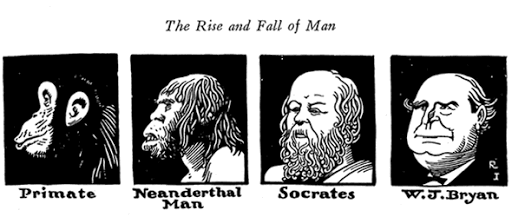
The New Yorker, June 6, 1925
At the turn of the twentieth-century the gloves came off. Scientism went to Total War. For men like Voliva and William Jennings Bryan, theirs was a last-ditch effort; and for anyone who decided to join them in the trenches by clinging to a literal interpretation of God’s Word, the bombardments were nothing short of shock-and-awe. Western philosophy and secular humanism were pulverizing them. Bryan, a globetrotting gap theorist, but a creationist all the same, was unfairly beaten down by the main stream media simply for daring to oppose academia’s evolving narrative in the Scopes Monkey Trial and taking the witness stand. Not long after, Voliva and his ministry succumbed to financial bankruptcy and controversy. By the 1950’s, Bryan and Voliva were dead, and their last remaining loyal followers, who had dominated dinner-table conversations only two decades earlier, were few enough in number to be forgotten—or too old to be remembered.
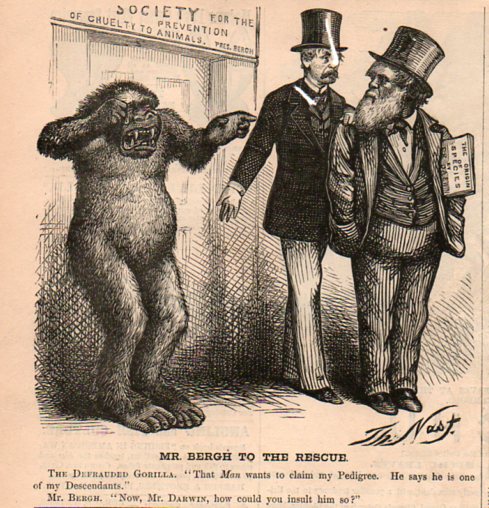
Harper’s Weekly, 1871
It may be safe to say that the flat earth Movement, if such a term should be accredited with geocentricism, officially began nearly a century earlier when, in the summer of 1838, seven years after Charles Darwin set off with Captain Robert Fitzroy for the Galapagos Islands, the Englishman Samuel Rowbotham waded into the old Bedford Canal. With a telescope positioned 8 inches above its surface, Rowbotham watched a boat mounting a red flag positioned three feet above the water row unhindered from his view until it finally reached Welney Bridge—the approximate and total length of Bedford’s six miles. A globular earth, Rowbotham maintained, should have buried the top of the mast 11 feet below his line of sight. Rowbotham repeated his experiments several times over the years. His observations would be published in 1849 and subsequently expanded into a book, Earth Not a Globe, in 1865. But once again, it arrived several years too late. Darwin’s On the Origin of Species landed on shelves five years earlier.
Rowbotham’s results received little notice.
The year was 1870, and Zetetic supporter John Hampden, a Protestant rector’s son and recent Oxford drop out, began publishing various tracts demanding that the Church of England be reformed “on strict Protestant lines” in order that Genesis might be defended with literal accuracy. Hampden’s initial influence, William Carpenter, had been convinced that the earth was flat through one of Rowbotham’s speeches. Carpenter’s book, Theoretical Astronomy Examined and Exposed, had hoped to injure the growing scientific establishment rather than receive the intellectual snubbing that it did. Hampden therefore had an idea. He offered a wager that he could demonstrate, by repeating Rowbotham’s experiment, that the earth was indeed flat. The January 12th issue of Scientific Opinion, a weekly journal, records Hampden’s qualm.
“What is to be said of the pretended philosophy of the 19th century, when not one educated man in ten thousand knows the shape of the earth on which he dwells? Why, it must be a huge sham! The undersigned is willing to deposit from £50 to £500, on reciprocal terms, and defies all the philosophers, divines and scientific professors in the United Kingdom to prove the rotundity and revolution of the world from Scripture, from reason, or from fact. He will acknowledge that he has forfeited his deposit, if his opponent can exhibit, to the satisfaction of any intelligent referee, a convex railway, river, canal, or lake.”
—JOHN HAMPDEN
Alfred Russel Wallace read the ad. Wallace was best known for independently conceiving the theory of evolution through natural selection, even jointly publishing his own work alongside contemporary Charles Darwin, which in turn prompted Darwin to ultimately send On the Origin of Species to the ink printer. At any rate, the bait was dangled, and Wallace tugged on the line—but not before first consulting his friend, Sir Charles Lyell, inventor of the geological column, asking whether he thought the challenge should be broached.
Lyell replied: “Certainly. It may stop these foolish people to have it plainly shown them.”
Wallace accepted the wager.
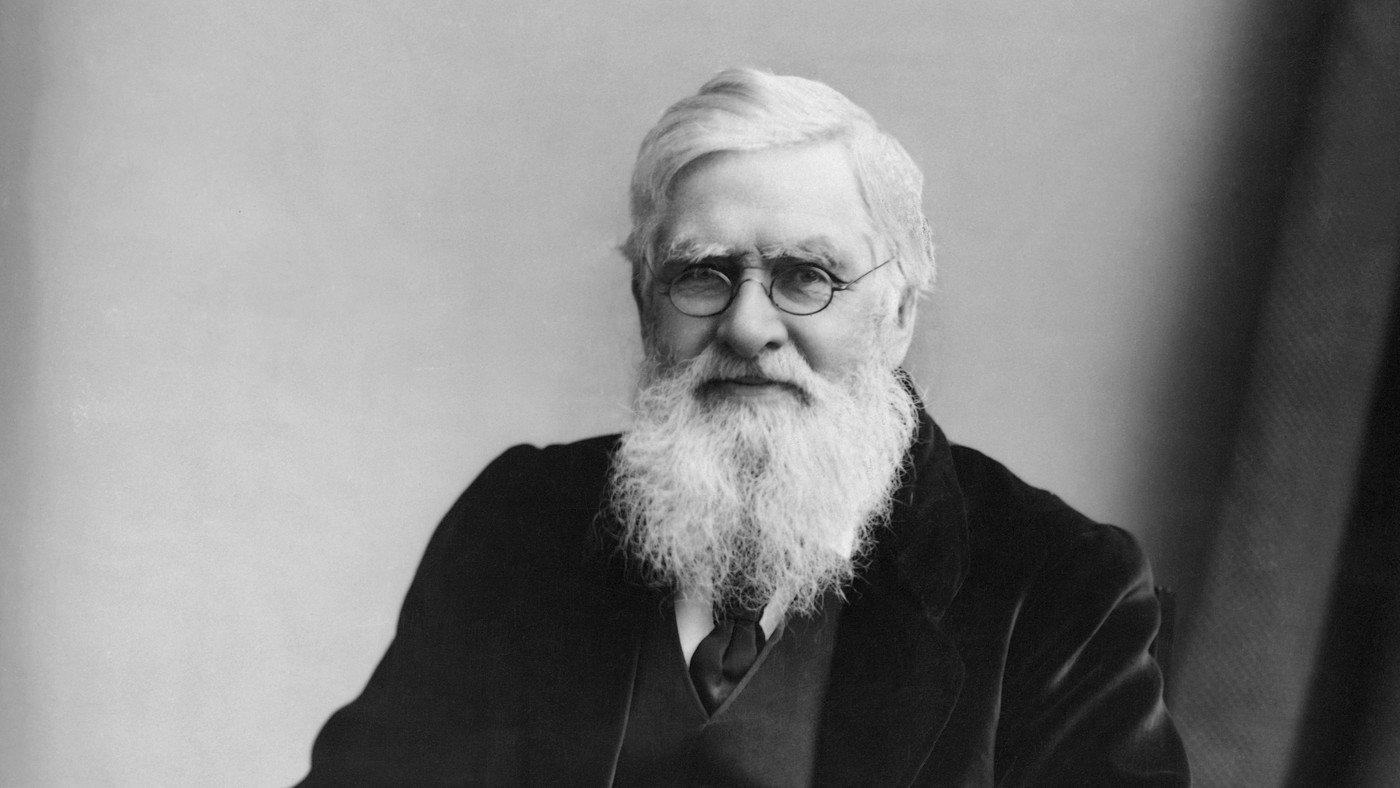
Alfred Russel Wallace (1823-1913)
Rather than simply positioning a mobile target three feet above the surface, as Hampden had intended, Wallace set a line of sight 13 feet high in order to reduce the effects of atmospheric refraction and then added a pole halfway down the six-mile canal in order that a “hump” could be detected on the curvature of the earth. Hampden initially refused the demonstration. Wallace however succeeded. He detected a hump. Evolution was spared. After the Darwinist was awarded the bet by their mediator, editor of The Field sports magazine, Hampden subsequently distributed a pamphlet alleging foul play. Wallace had cheated, he said. And to prove that point, Hampden took him to court.
Though the court ultimately ruled that the wager had been invalid to begin with, the flat earthist was imprisoned for libel and furthermore threatening to kill the Darwinian. Speaking of which, for his injudicious involvement in a bet to “decide the most fundamental and established of scientific facts,” Wallace was criticized by Darwin’s contemporaries to no end. Until his dying days, the Bedford Level, Wallace maintained, was the foremost regret of his life.
He later wrote:
“The next matter was a much more serious one, and cost me fifteen years of continued worry, litigation, and persecution, with the final loss of several hundred pounds. And it was all brought upon me by my own ignorance and my own fault—ignorance of the fact so well shown by the late Professor de Morgan—that ‘paradoxers,’ as he termed them, can never be convinced, and my fault in wishing to get money by any kind of wager. It constitutes, therefore, the most regrettable incident in my life.”
Decades before Wallace’s involvement and even afterward, the Bedford Canal became a rallying cry of Biblical literalism, particularly in England. As the 19th century closed, Lady Elizabeth Anne Blount carried on Rowbotham’s work in founding the Universal Zetetic Society. Her wealth and social status allowed access to England’s social elite, and her Earth Not a Globe Review, which not only matched Scripture with scientific observation, further advocated vegetarianism and anti-vivisectionist views. On the 11th of May, 1904, Lady Blount revisited the Bedford Canal by hiring a commercial photographer and globe supporter in Edgar Clifton, with hopes of dashing Wallace’s evolutionary earth to pieces. To do so, Blount dropped a large white sheet at Rowbotham’s original starting position (some 70 years earlier) in order that the photographer, using a telephoto lens camera mounted two feet above the water, might capture its bottom edge from Welney Bridge, six miles away, which he did—spectacularly. He saw it all.
Clifton was stumped.
The Darwinists simply ignored the Zetetics.
Perhaps this is because Henry Yule Oldham, a senior academic in geography at King’s College, Cambridge, had already reproduced Wallace’s results in 1901 using three poles fixed at equal height above water level. So contemptuous were the Darwinists towards Rowbotham’s little Level experiment and John Hampden’s wager that Bedford was taught in schools as proof of the Earth’s curvature. For the following half century, until the space race could produce photos, generations of children were raised worldwide to learn that the earth was provably a globe because the Darwinists had conquered the Copernican revolution by defeating flat earthists.
It was the perfect propaganda.
Elsewhere in the world, Ulysses Gran Morrow, a newspaper editor, replicated a similar experiment on the old Drainage Canal in Summit, Illinois. The date was July 25, 1896. In doing so, Morrow also attempted to prove the earth was spherical—but there was a catch. Morrow was sponsored by a man named Cyrus Reed Teed, an eclectic physician and alchemist who had by now claimed divine inspiration and a messianic anointing, furthermore taking the name Koresh. Together they hoped to prove the earth was concave.
Koresh called it Koreshanity.
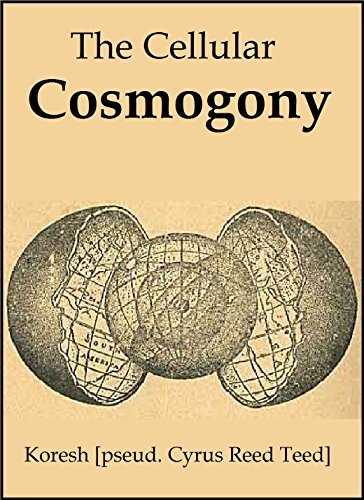
Fundamentally, Koreshanity posited that the earth and sky, the sun, moon, and stars exist inside the surface of a sphere—essentially globe earth inverted. Though Koresh initially found some success in San Francisco, he eventually proposed a New Jerusalem in the 320-acre plot of Estero, Florida, 15 miles south of Fort Myers. His newfound paradise was incorporated on September 1, 1904. Like Jim Jones several decades after him, his followers came in droves.
Wilbur Glenn Voliva heard about it. In the suburbs of Chicago, Voliva wanted a New Jerusalem of his own.
By 1907, Alexander John Dowie, the man who called himself Elijah, was dead. Upon his request, Dowie’s grave was filled with concrete, once his coffin was secured inside, in order to stave off any potential rumor that his body had been stolen—that is, in the event of resurrection, a rumor in which Dowie started. Was Wilbur Glenn Voliva concerned? Not likely. Despite once being billed as his most loyal follower, Voliva had successfully wrestled the grand Utopian vision from the theocrat who’d envisioned it, with a slanderous shock and awe press campaign to follow. Finally, Dowie was gone forever—good riddance. Zion City was his now. One tyrant was traded in for another.
Meanwhile, back in Florida, Koresh’s death in 1908 proved a serious bummer to his causes, particularly since the self-anointed Messiah claimed to be immortal.
Neither he nor Dowie resurrected.
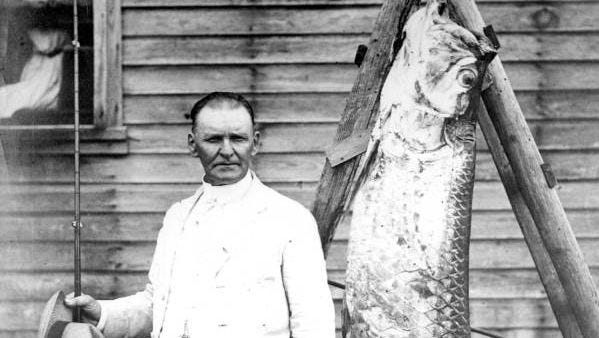
Koresh (1839-1908)
Throughout the following four decades Voliva would successfully rule over one of the most reviled and yet simultaneously awe-inspiring churches and communities of the twentieth-century. The rigid rules and regulations enforced upon Zion’s citizens became a legendary roadmap for Prohibition to come. It was there in Zion—the land of Dowie’s grand design; that the flat earth movement would take its next grand stand. Though Voliva had one accused Dowie of “extravagance, hypocrisy, misrepresentations, exaggerations, misuse of investments, tyranny, and injustice” in order to douse his leadership credibility, by the end of the First World War, Voliva began painting himself in even broader strokes than Dowie by billing himself “The World’s Richest Holy Man.”
The world took notice.
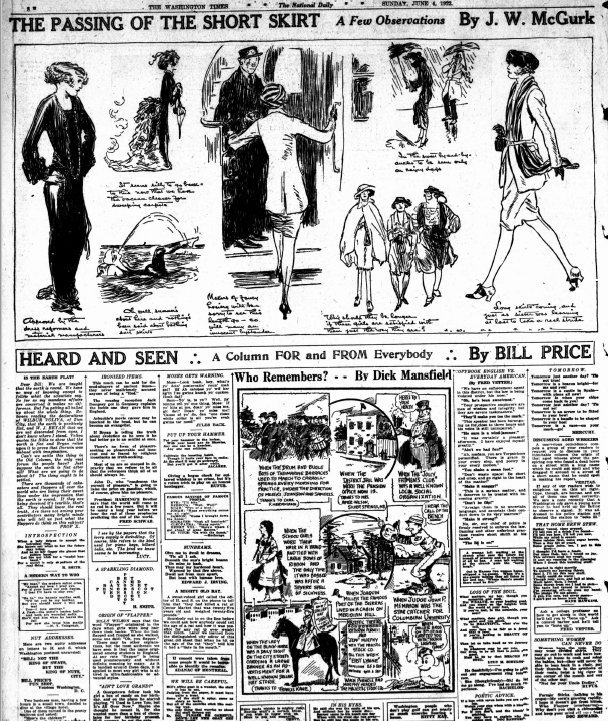
On Sunday, June 4, 1922, from a Washington Times column titled: “HEARD AND SEEN: A Column FOR and FROM Everybody,” the following question is asked of columnist Bill Price.
IS THE EARTH FLAT?
Dear Bill:
We are taught that the earth is round. We have no way of knowing except to follow what the scientists say. So far as my mundane affairs are concerned it makes no difference. But I’m getting all balled up about the whole thing. Between reading the declarations of WILBUR VOLIVA, of Zion City, that the earth is positively flat, and W. J. BRYAN that we are not descended from apes, I don’t know where I stand. Voliva quotes the Bible to show that the Earth is flat and Bryan relies upon it to prove that Darwin was imbued with imagination.
Can’t we settle this thing in the Old Column, the only real forum the people have? Just suppose the earth is flat after all. What are we going to do about it? The thing ought to be settled.
There are thousands of cake-eaters and flappers all over the World who are living their sweet lives under the impression that the earth is round. If they are being deceived it’s terrible, that’s all. They should know the real truth. Are there not among your contributors many bright minds who will tell us just what the flappers do think on this subject?
—PROF X.
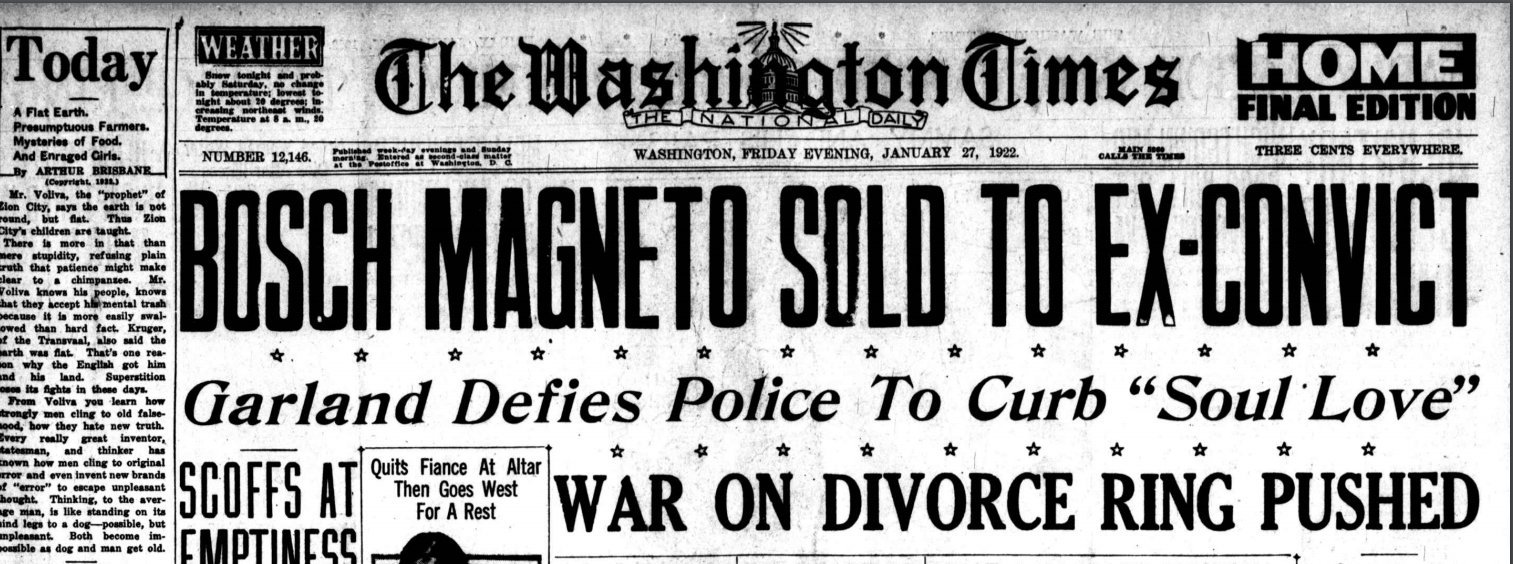
Earlier that year, The Washington Times ran a far less flattering story. On Friday, January 27, 1922, columnist Arthur Brisbane, clearly not a fan of Flat Earth, Voliva, or the Bible, wrote:
“Mr. Voliva, the ‘prophet’ of Zion City, says the earth is not round, but flat. Thus, Zion City’s children are taught.
There is more in that than mere stupidity, refusing plain truth that patience might make dear to a chimpanzee. Mr. Voliva knows his people, knows that they accept his mental trash because it is more easily swallowed than hard fact. Kroger, of the Transvaal, also said the earth was flat. That’s one reason why the English got him and his land. Superstition loses its fights in these days.
From Voliva you learn how strongly men cling to old falsehood, how they hate new truth.
Every really great inventor, statesman, and thinker has known how men cling to original error end even invent new brands of “error” to escape unpleasant thought Thinking, to the average man, is like standing on its hind legs to a dog—possible, but unpleasant. Both become impossible as dog and man get old.”
Even George Orwell, author of Animal Farm and 1984, chimed in on the conversation. On the 27th of December 1946, as part of his “As I Please” column, the author wrote a piece titled: “How Do You Know the Earth is Round?” He began his article by stating:
“Bernard Shaw remarks that we are more gullible and superstitious today than we were in the Middle Ages, and as an example of modern credulity he cites the widespread belief that the earth is round. The average man, says Shaw, can advance not a single reason for thinking that the earth is round. He merely swallows this theory because there is something about it that appeals to the twentieth-century mentality.”
The battle for the flat earth was real. This was the world which parented Charles Schulz and his generation. Schulz however would father another. By the time Linus, Lucy, Schroeder, Charlie Brown, Peppermint Patty, Marcie, Franklin, Pig-Pen, Snoopy and their fellow baby-boomers were born, the outcome was almost certain. Within twenty years of their conception, the space race would achieve its ultimate mission. Not only was the Soviet Union to be humiliated—the Bible was too. That’s two birds with one stone. The appeal of “twentieth-century mentality,” as Orwell put it, won over. The Bible’s “mental trash,” to quote Brisbane, particularly from those clinging to its “old falsehood,” did not.

GLOBE PROOF
CHARLIE BROWN FIRST LEARNED ABOUT planet Earth as most of us did—in the classroom. The date was October 27, 1950, only three weeks after Peanuts first premiered, and Shermy’s claim that a schoolroom globe is “proof” of its spherical nature did not pass by Brown without an initial air of skepticism. But where apprehension is concerned, Charles Kenneth Johnson’s introduction to the schoolroom globe was carried out in a slightly more dramatic fashion. Born on his father’s cattle ranch in Tennyson, Texas, on July 24, 1924, only two years after Schulz, Johnson would never forget the day when, in the second or third grade, his teacher introduced them to the very thing.
“Now they brought out this globe,” he later recalled. “It wasn’t like today, they didn’t have globes everywhere, and people didn’t say globe every few minutes. They put out this globe, and started the propaganda on it. I didn’t accept it from the start. You can see the thing is false! It’s quite obvious. I can see it today the same as I saw it there.”
A ball with water on it—and the water just hangs there? The eight-year-old thought. Why don’t ships sail over the edge and fall off?
He then spoke his concerns out loud. His teacher immediately and publicly rebuffed his concerns. But Charles Kenneth insisted. Mam, this is a sham. The boy was sent home from school with an added homework assignment. He was to fetch a bucket, fill it with water, swing it round and observe the centrifugal force which held the water in place, as Newtonian laws of motion implied.
Not a single moment was wasted. Here Johnson further recalled: “I got a bucket of water and I whirled it around. It didn’t come out, but I saw at the same time that it had nothing to do with the globe. This was absurd. So I knew there was a lie here. Maybe I was extra smart or extra something for my age. I see other things they told us in school weren’t true. But that was the big one. I knew it and I’ve always known it. It’s a complete world of lies, telling you things they know when they really don’t know it. I always knew that the Earth was not a ball. I pondered for a while about how I could prove otherwise, but I didn’t want to spend any time dwelling on it. I just knew that the Earth was flat.”
He later told a Chicago Tribune reporter, “The water was rigid in the bucket. It wasn’t moving, like people, cars, trucks, trains, and animals do.”
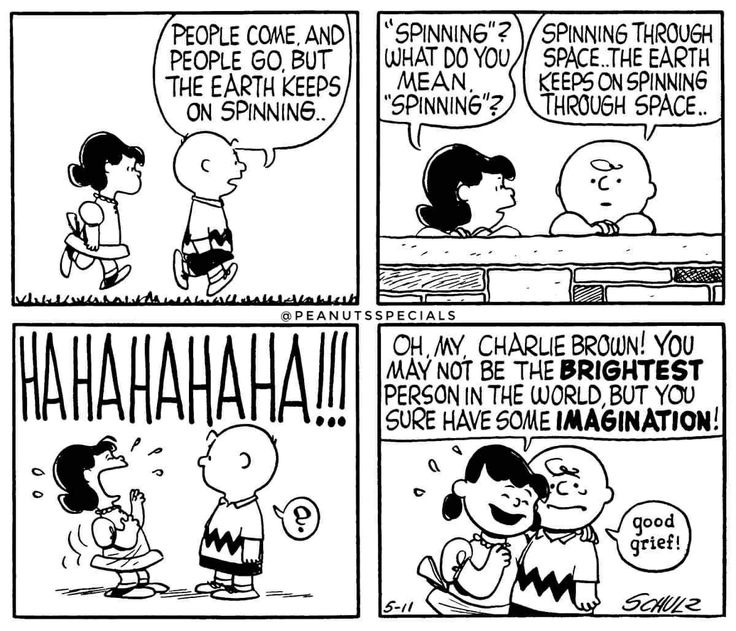
By May 11, 1957, some seven years after Charlie Brown’s initial introduction, Brown was thoroughly indoctrinated—though apparently glum about it, as one would expect of America’s favorite block-head. Lucy however had not passed the exam, because the thought of an Earth “spinning through space” was laughable at best—and reserved for one’s wildest imaginations.
“People come and people go, but the Earth keeps on spinning,” says Charlie Brown.
“Spinning?” Lucy asks from behind a stone wall. “What do you mean, spinning?”
“Spinning through space….” Charlie brown explains. “The Earth keeps on spinning through space.”
Lucy explodes into laughter: “Oh, my, Charlie Brown! You may not be the brightest person in the world, but you sure have some imagination!”
“Good grief!”
Charles Johnson, however, was never convinced. While his schoolmates learned about the globe and then fleshed out what imaginations a globular Earth offered on the playground, Johnson poured through library books, searching knowledge, desperately seeking answers—all the while striving to withstand the monotonous persuasions of his school regime. It was there in the library where he acquainted himself with Freud, Einstein, and Dickens on his own. As a pubescent, Johnson later quipped that he’d already acquired more knowledge than the average University graduate. And then one day the young Johnson happened upon an article in Harper’s Magazine concerning Zion’s overseer, Wilbur Glenn Voliva.
Again, Johnson recalled: “I knew in a split second, when I read in Harper’s Magazine, just check the water. I said, ‘My God! Why didn’t I think of that?’ I vowed that the minute I’d get to a lake, I’d check it. I knew from that second then how to prove it.”
The boy wrote the ailing Voliva a letter.
Voliva responded.
And then he died. With Voliva finally buried (good riddance), the Utopian hopefuls of Zion, Illinois abandoned his teachings just as quickly, and with as much dramatic hand wiping, as Voliva had with Dowie. With the outbreak of the Second World War, particularly the atomic age to follow, flat earth was an embarrassment to almost everyone involved.
Charles Johnson would have to wait nearly another two decades before a certain Samuel Shenton of Dover, England, would take up the fight alone.

Charles Schulz (1922-2000)
CHARLIE BROWN
THERE’S A REASON WHY Peanuts REVERBERATED so well with the adult crowd, especially college students—beatniks, hipsters, and eventually, as the sixties progressed, with hippies. In 1957, adults would have gotten the joke. But perhaps more importantly, they would have had a sort-of first-hand appreciation for it. They were laughing at their superstitious grandparents, and maybe even their crazy uncles. Schulz said it like this: “I feel that Peanuts reflects certain attitudes of life in our country today and perhaps some basic fears.” For most Cold War-era Americans, the very idea of a flat stationary Earth exhumed all the bad tastes associated with the food poisoning from a past memory—proof of religious zealotry gone tragically wrong. Lucy Van Pelt came with a fist, and she could even pound it into the creative gut of Schulz himself. She was crabby, for one—or in her case, a fuss budget—authoritatively bossy, judgmental, at times sadistic (when a football was involved), and for all her attempts at leading Charlie Brown through psychological therapy (which may have also included a football—now that I think on it), stunningly arrogant.


Consider one of Schulz’s most enduring strips. On September 19, 1966, Snoopy’s house burned to the ground. Lucy’s response can best be summed up in everything that Schulz likely saw wrong with Christian fundamentalism. While the cause of the fire was never revealed, for Lucy, the conclusion came easy. Snoopy, she said, had sinned.
To blindly call Schulz a “Christian apologist” or evangelical spokesman is to brown-nose his strip with wishful thinking. In part, he curbed his own contemplations with the changing moralities of his time. Schulz’s most morbid view of religion comes, I believe, with Lucy’s younger brother—the serial Scripture-memorizer, Linus Van Pelt. His undying devotion to the Great Pumpkin is nearly as unbearable to watch for the agnostic after humanist Thomas Payne’s own heart as Charlie Brown’s blind faith in Lucy, who is completely incompetent in her promises to hold his football in place.
And yet here is another account of Peanuts lasting power—Schulz’s clever ability to pander to everyone. In June of 1963, the Supreme Court ruled 8–1 in favor of Edward Schempp, thereby declaring school-sponsored Bible reading in public schools in the United States to be unconstitutional. Schulz followed that decision on November 3rd, 1963 with one of Peanuts most nostalgic and hotly-debated moments.
After making sure the coast is clear, Sally beckons her brother Charlie Brown to follow her behind the couch so that she can whisper into his ear: “We prayed in school today.”
Charlie brown is aghast.
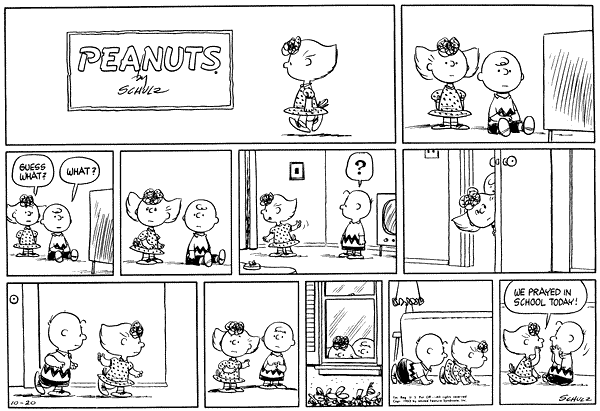
Sally’s confession masterfully played to the emotions of both sides, and not only proved a rallying cry for Christian groups across America, who cried foul at the Supreme Court’s decision; it doubled-down as a banner for atheist groups too. Everyone concurred with Sally.
Some will claim I am being unfair. And yet, despite his Christian upbringing, it is clear—by his own testimony—that the creator of Peanuts had changed. The man who once fought CBS Executives to keep Linus’ speech intact at the end of A Charlie Brown Christmas; which first aired in 1965—had changed. The man who once berated Hank Ketchum’s use of shallow spirituality in Dennis the Menace, as well as Bil Keane’s The Family Circus—had changed. The very man who once taught Sunday school and quipped: “I preach in these cartoons, and I reserve the same rights to say what I want to say as the ministers in the pulpit,” simply shriveled up inside and died. Perhaps he had been punched in the creative gut too many times by Lucy Van Pelt, because Charles Schulz gave up on church. But far worse, he gave up on Yeshua, because in the sunset of his life Schulz unashamedly referred to himself as a “secular humanist.” Not only had the Bible lost its credibility as the final authority on philosophical matters, including a salvation which could only come through Yeshua, but other religions now filled the void—all of which provided the hope of legitimate paths to God.

Schulz confessed: “I do not go to church anymore. I guess you could say I’ve come around to secular humanism, an obligation I believe all humans have to others and the world we live in.”
As Schulz faith slipped through the very fingertips which so devoutly held his creative pen and outlined his sketches for five-consecutive decades, he asked his readers to do the same. In a January 1986 strip, Sally asked Charlie Brown: “When we die, will we go to Heaven?”
Charlie Brown’s response was: “I’d like to think so.”
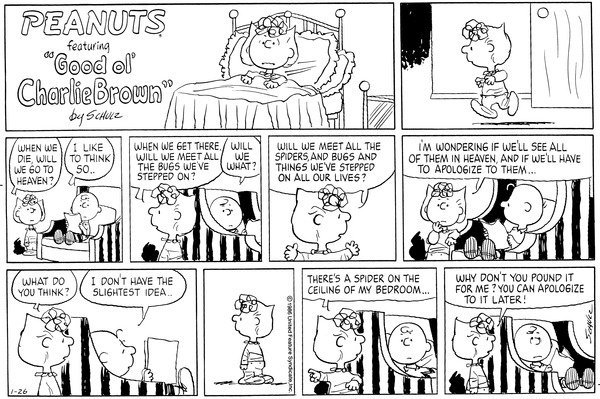
At any rate, in October of 1950, the mere fact that a classroom globe could be used as proof of a proposed spherical Earth—and made to be a joke—was a confessional in and of itself that Schulz had at least been in on the table-talk. By 1957, he’d passed it off as a gross and arrogant error of fundamentalism. In March of 1969, Snoopy beat not only Apollo 11 and the Russians to the moon, but “the stupid cat next door.” During the 1980’s, Schulz was clearly all in. Who needed the globe for indoctrination? With “This Is America, Charlie Brown!” a series of made-for-TV episodes which gave aide to American patriotism, the Peanuts journeyed aboard the International Space Station. And during the last decade of his life, the very notion of Evangelist Wilbur Glenn Voliva’s claim—that the Bible was literally true and the Earth was flat—was a disposable joke.

Woodstock, we come to find out, is a Flat Earthist—this according to Snoopy’s brother, Andy. It is October 17th, 1997, and Schulz casts the same grin of mockery that so many seem to possess the moment they find out that the golden canary and Biblical literalists have something in common. You know, “Why don’t you do us all a favor and jump off the edge of the Earth?”
Olaf, being Snoopy’s fat, dopey, and rather gullible brother, does just that.
-Noel

